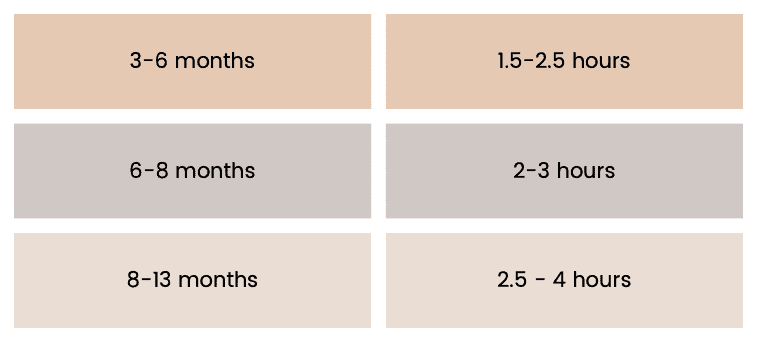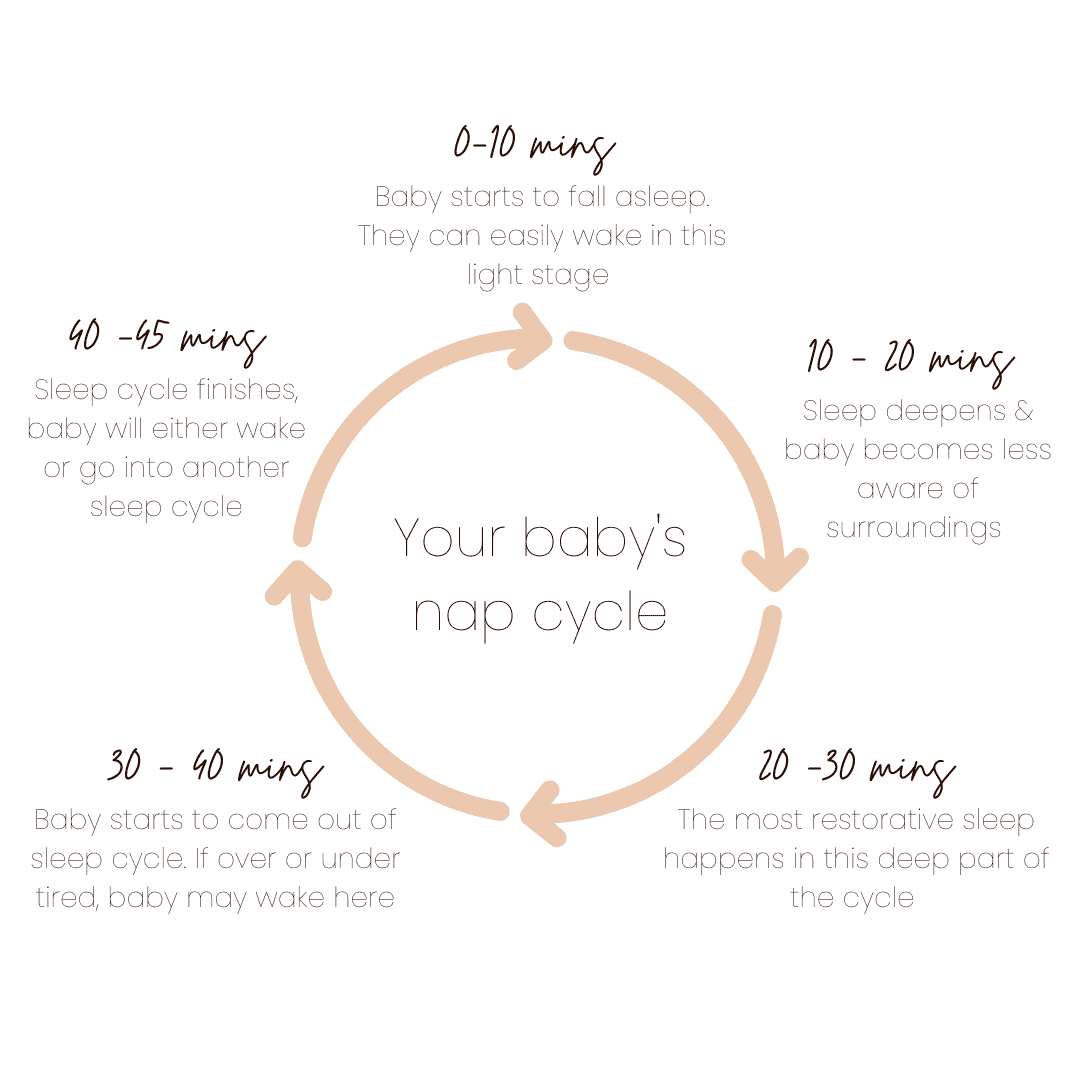Five months old is such an exciting age for your new baby. Your little one likely feels so much more engaging and fun to hang out with all of a sudden. They babble away, play with toys, and are more alert during the day. You may have started taking them to baby classes and love watching them develop and take in the world around them.
But how does all this amazing change and growth relate to your baby’s sleep? Does it make it harder or easier? Unfortunately, it’s likely to be a bit of both! The good news is that all this growth now means your baby can sleep for longer stretches and go longer without a feed. The bad news is development and change in your baby’s world often throw up some sleep disruption too.
I’m Chloe Waller, a gentle sleep coach, and in this article, we will have the 5 month old wake window explained, nap schedule and everything else that may be impacting their sleep.
Wake, what?
As a sleep coach, I have been guilty of waxing lyrical about wake windows to anyone who’ll listen before someone kindly stops me to ask, ‘sorry, what is a wake window?!’
So, to avoid further confusion, let’s start with the basics. A wake window is simply the optimum time for your little one to be awake between their naps.
The shortest wake window of the day is always the first, between waking for the day and the first nap. Then wake windows will gently lengthen throughout the day, the longest being before your baby goes to bed.
Wake windows help us find the ideal amount of sleep for our baby. They are also helpful tools in finding a routine that works specifically for your little one and their sleep needs. A great place to start with wake windows is with the averages. Below is a chart of the average wake window lengths for your baby in their first year:
When looking at a 5-month-old baby, their wake window average is between 1.5 – 2.5 hours. This means their first nap of the day may still be relatively soon after they get up, around 90 minutes. Then the wake window will lengthen throughout the day, with bedtime roughly 2.5 hours after waking from their last nap.
Your baby will likely be taking three naps a day at this age, but some babies, who need a bit more sleep than average, may still be taking four naps. I want to reassure you that this is normal, especially if your baby like to take shorter naps. For example, my son took four naps a day until he was almost 6-months old. Some babies do better with shorter, more frequent naps; there’s nothing wrong with that!
Sleepy Signs
A quick and easy way to find your baby’s perfect wake window is to watch them for sleepy signs. These are physical signals that your baby is tired and should go to sleep soon.
There are ‘early’ and ‘late’ sleepy signs, which you see depends on how tired your baby is! The early signs can be very subtle and might be things you’ve seen before but hadn’t yet realised were sleep signals. Late sleepy signs are more pronounced, and you may be more familiar with some of these.
Early Sleepy Signs
- Glazed expression
- Red-rimmed eyes
- Losing interest in toys or people
- Looking pale
- Going quiet
Late Sleepy Signs
- Grimacing
- Rubbing eyes
- Arching back
- Vigorous wriggling
- Rubbing face into parents neck or shoulder
When watching your baby for sleepy signs, be curious and note the cues you’re seeing and at what times. Keeping a simple sleep diary for a few days can help you determine a pattern and find the correct timings for your unique little one.
If it takes you some time to figure out these signs, don’t panic. It can take a while to get to know your baby’s sleepy signals; some babies are very subtle.
Sleep Pressure
During your baby’s wake window, they build sleep pressure. Sleep pressure is the build-up of adenosine in the body which helps us feel sleepy and to fall asleep. Sleep pressure helps our little ones fall asleep and stay asleep if the balance of their sleep is correct.
Unfortunately, letting our babies stay up longer in the hope they build more sleep pressure and therefore sleep longer does not work. You’re more likely to end up with a completely wired baby who will not calm down or settle. And you’ve probably already learned that the hard way!
As well as looking at wake windows for your baby, it is also important to look at sleep across 24 hours. For a 5-month-old, I’d hope to see 4-5 hours across daytime naps and 9-10 hours overnight, often with a feed or two. Again, it’s important here to stress that these are averages. Your baby might need slightly more or slightly less sleep than this.
Your Baby’s Sleep Cycle
I’ve found that knowledge is power for most families I work with. And by helping them understand their baby’s nap cycle, they feel more relaxed and comfortable if their baby is taking shorter naps.
The chart below shows how your baby sleeps during a nap. As you can see, if your baby is napping for roughly 40 mins at a time, that is normal. That is one of their sleep cycles, meaning they haven’t quite learnt how to link their sleep cycles yet.
This will happen in time, or you can encourage this by looking at how they fall asleep and by working on some gentle self-settling methods. Often, suppose a baby is used to falling asleep with outside help, for example, feeding or rocking to sleep.
In that case, they will need that same assistance to fall back asleep once they wake up from their sleep cycle.
Step-By-Step: How To Find Your Baby’s Wake Window
Now that you understand your baby’s sleep at five months old let’s give you a simple, effective method for finding your baby’s wake window.
- Keep a written sleep diary for a few days. Note down when your baby is falling sleeping and for how long.
- Be curious about your baby and watch them for their early and late sleepy signs, noting them in your sleep diary.
- Analyse your findings; a natural pattern is likely emerging.
- When you’ve found your ideal wake window, get ahead of it! Start getting your baby ready for their nap 10 minutes before this time, so they have ample time to settle gently and ease into their sleep.
Schedules vs Wake Windows
If you are enjoying being curious about your baby’s sleepy signs and wake windows, you may find your timings for their naps change day to day. Some parents are more go-with-the-flow regarding schedules, and if that works for you, great! Your schedule may change for a few reasons; your baby wakes up at different times each morning, has been at a baby class and is more tired than usual, or might be experiencing teething. There are various reasons a schedule can ebb and flow. The timings won’t be dramatically different, but you won’t have strict times for when your baby should be sleeping.
However, many parents hope to follow a more consistent routine by this age. It can make life easier if each day feels more predictable & you can comfortably make plans. If that’s you and you’re more of a routine-based person (no judgement here, that’s me too!), then here’s an example schedule you can follow for your 5-month-old:
7 am – wake & feed
90-minute wake window
8.30 am – First nap
2-hr wake window
11.30 am Second nap
2-hr wake window
3 pm Third nap
2.5-hr wake window
6.30 pm bedtime
If you’re hoping to put your baby to bed at 7 pm, wake them by 4.30 pm from their last nap of the day to protect bedtime and give ample time for sleep pressure to build.
New Skills & Baby Sleep
Each baby is different, and all develop at their own pace, but as your baby turns five months old, they may suddenly start to feel very active to you. That’s because some exciting developmental milestones are happening around this age; hello, rolling! Some of the milestones you may be experiencing are:
- Sitting with props
- Bringing toys or objects to their mouth
- Babbling
- Rolling front to back
Now, however exciting these physical changes and milestones are, they can bring some sleep disruption. These new skills are processed in your baby’s brain while they sleep, which can often cause more frequent night wakings.
When developing a new skill, the best thing you can do to minimise night disruptions is to practice, practice, practice! During the day, away from sleep, practice your baby’s new skills with them and encourage them to explore. It’s also lovely to bond with them and get excited about their fantastic progress.
A note on rolling; if your baby has started rolling in their crib at night and gets stuck on their tummy, ensure you are returning them to their back to maintain safe sleep guidelines. Once your baby has mastered rolling both ways, you can leave them to roll in their cot at night.
Remember, there is no ‘right’ way for your baby to sleep. It’s important you follow their lead and your instincts as their parent and find a routine that works well for your baby and your family.
Don’t hesitate to contact your paediatrician if you have concerns about your baby’s development. For more practical help and advice on your baby’s sleep, please visit Upside Dad.
FAQs – 5 Month Old Wake Window Explained
Question: How long should naps be at five months?
Answer: Naps can still be unpredictable at this age. Anywhere from 30 mins to 2 hours is expected. Ideally, we’d like at least one chunkier nap of an hour or more. However, many babies are still cat nappers at this age and will only nap for 30 mins at a time. In this case, your baby might nap four times a day instead of three. On average, a 5-month-old sleeps for about 4 hours throughout the day.
Question: What time should a 5-month-old go to bed?
Answer: At this age, your baby’s body clock will be firmly established, so a bedtime around 7 pm would be appropriate. Having said that, most babies I work with benefit from a slightly earlier bedtime of 6.30 pm. The main thing to remember is that the last wake window before bedtime is the correct length, on average, 2-2.5 hours. If your baby’s last nap ends around 4.30 pm, then a 7 pm bedtime is perfect.
Question: Can a 5-month-old sleep through the night?
Answer: Yes, some babies can sleep through the night at five months old, but most babies still need to feed through the night at this age. The average age to drop night feeds entirely is around 8-9 months; some still need a feed until they are 12 months old.
Question: Is there a sleep regression at five months?
Answer: The four-month sleep regression can start as early as three months or as late as five months. For most, it’s around the four-month mark, but all babies develop at their own pace, depending on when their sleep cycles are changing and becoming more adult-like. If you think your baby might be in the four-month sleep regression, you can read up on the key signs and how to manage sleep regressions here.
Read Also:
Chloe is a certified Infant Sleep Consultant and Founder of The Sleep Guide where she works with tired parents to transform their baby’s sleep using gentle, actionable sleep teaching methods to give them confidence in their little one’s sleep.




